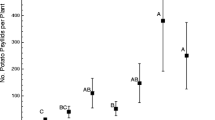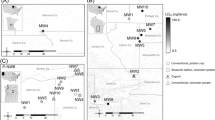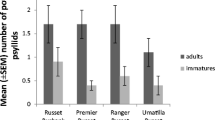Abstract
The potato psyllid, Bactericera cockerelli, is a key pest of potato and important vector of the pathogen that causes zebra chip disease. Control of zebra chip relies entirely on the use of insecticides to reduce populations of this vector. The development of potato varieties resistant to B. cockerelli would contribute to cost-effective control of this insect. Wild potato germplasm are key sources for desirable traits including pest resistance to develop new potato cultivars. Our objective was to screen Solanum bulbocastanum germplasm for resistance to B. cockerelli. The combined use of choice and no-choice assays demonstrated considerable variability among S. bulbocastanum populations in their susceptibility to psyllids. At least six S. bulbocastanum populations exhibited resistance to B. cockerelli: PI 243512, PI 243513, PI 255518, PI 275194, PI 275197, and PI 283096. The documentation of the variability among S. bulbocastanum germplasm populations in their susceptibility to B. cockerelli can aid the development of potato cultivars that are naturally resistant to the potato psyllid.
Resumen
El psílido de la papa, Bactericera cockerelli, es una plaga clave de la papa y un vector importante del patógeno que causa la enfermedad del tubérculo rayado o “zebra chip”. El control de esta enfermedad se confía completamente en el uso de insecticidas para reducir las poblaciones de este vector. El desarrollo de variedades de papa resistentes a Bactericera cockerelli contribuirá al control costeable de este insecto. El germoplasma silvestre de papa es una fuente clave para características deseables incluyendo resistencia a plagas para el desarrollo de nuevas variedades. Nuestro objetivo fue evaluar germoplasma de Solanum bulbocastanum para resistencia a B. cockerelli. El uso combinado de ensayos de selección y no selección demostró variabilidad considerable entre poblaciones de S. bulbocastanum en su susceptibilidad a los psílidos. Por lo menos seis poblaciones de S. bulbocastanum exhibieron resistencia a B. cockerelli: PI 243512, PI 243513, PI 255518, PI 275194, PI 275197, y PI 283096. La documentación de la variabilidad entre las poblaciones del germoplasma de S. bulbocastanum respecto a su susceptibilidad a B. cockerelli puede ayudar en el desarrollo de variedades de papa que son resistentes de forma natural al psílido de la papa.
Similar content being viewed by others
References
Butler, C.D., and J.T. Trumble. 2012. The potato psyllid, Bactericera cockerelli (Sulc) (Hemiptera: Triozidae): life history, relationship to plant disease, and management strategies. Terrestrial Arthropod Reviews 5: 87–111.
Butler, C.D., B. Gonzalez, K.L. Manjunath, R.F. Lee, R.G. Novy, J. Creighton Miller, and J.T. Tumble. 2011. Behavioral responses of adult potato psyllid, Bactericera cockerelli (Hemiptera: Triozidae), to potato germplasm and transmission of Candidatus Liberibacter psyllaurous. Crop Protection 30: 1233–1238.
Davis, J.A., E.B. Radcliffe, C.A. Thill, and D.W. Ragsdale. 2012. Resistance to aphids, late blight and viruses in somatic fusions and crosses of Solanum tuberosum L. and Solanum bulbocastanum Dun. American Journal of Potato Research 89: 489–500.
Diaz-Montano, J., B.G. Vindiola, N. Drew, R.G. Novy, J. Creighton Miller, and J.T. Tumble. 2013. Resistance of selected genotypes to the potato psyllid (Hemiptera: Triozidae). American Journal of Potato Research. doi:10.1007/s12230-013-9356-6.
Edwards, D., and J.J. Berry. 1987. The efficiency of simulation-based multiple comparisons. Biometrics 43: 913–928.
Flanders, K.L., J.G. Hawkes, E.B. Radcliffe, and F.I. Lauer. 1992. Insect resistance in potatoes: sources, evolutionary relationships, morphological and chemical defenses, and ecogeographical associations. Euphytica 61: 83–111.
Flanders, K.S., E.B. Radcliffe, and J.G. Hawkes. 1997. Geographical distribution of insect resistance in potatoes. Euphytica 93: 201–221.
Graham, K.M., J.S. Niederhauser, and L. Servin. 1959. Studies on fertility and late blight resistance in Solanum bulbocastanum Dun. in Mexico. Canadian Journal of Botany 37: 41–49.
Helgeson, J.P., J.D. Pohlman, S. Austin, G.T. Haberlach, S.M. Wielgus, D. Ronis, L. Zambolim, P. Tooley, J.M. McGrath, R.V. James, and W.R. Stevenson. 1998. Somatic hybrids between Solanum bulbocastanum and potato: a new source of resistance to late blight. Theoretical and Applied Genetics 96: 738–742.
Hermsen, J.G., and M.S. Ramanna. 1973. Double-bridge hybrids of Solanum bulbocastanum and cultivars of S. tuberosum. Euphytica 22: 457–466.
Jansky, S.H. 2000. Breeding for disease resistance in potato. Plant Breeding Review 19: 69–155.
Le Roux, V., E.D.M. Campan, F. Dubois, C. Vincent, and P. Giordanengo. 2007. Screening for resistance against Myzus persicae and Macrosiphum euphorbiae among wild Solanum. Annals of Applied Biology 151: 83–88.
Liefting, L.W., Z.C. Perez-Egusquiza, G.R.G. Clover, and J.A.D. Anderson. 2008. A new ‘Candidatus Liberibacter’ species in Solanum tuberosum in New Zealand. Plant Disease 92: 1474.
Liefting, L.W., P.W. Sutherland, L.I. Ward, K.L. Paice, B.S. Weir, and G.R.G. Clover. 2009. A new ‘Candidatus Liberibacter’ species associated with diseases of solanaceous crops. Plant Disease 93: 208–214.
Munyaneza, J.E. 2012. Zebra chip disease of potato: biology, epidemiology, and management. American Journal of Potato Research 89: 329–350.
Munyaneza, J.E., J.M. Crosslin, and J.E. Upton. 2007. Association of Bactericera cockerelli (Homoptera: Psyllidae) with “zebra chip”, a new potato disease in southwestern United States and Mexico. Journal of Economic Entomology 100: 656–663.
Park, T.H., J. Gros, A. Sikkema, V.G. Vleeshouwers, M. Muskens, S. Allefs, E. Jacobsen, R. Visser, and E.A. van der Vossen. 2005. The late blight resistance locus Rpi-blb3 from Solanum bulbocastanum belongs to a major late blight R gene cluster on chromosome 4 of potato. Molecular Plant-Microbe Interactions 18: 722–729.
Pelletier, Y., J. Pompon, P. Dexter, and D. Quiring. 2010. Biological performance of Myzus persicae and Macrosiphum euphorbiae (Homoptera: Aphididae) on seven wild Solanum species. Annals of Applied Biology 156: 329–336.
Pfeiffer, D.G., and E.C. Burts. 1983. Effect of tree fertilization on numbers and development of pear psylla (Homoptera: Psyllidae) and on fruit damage. Environmental Entomology 12: 898–901.
Plaisted, R.L., and R.W. Hoopes. 1989. The past record and future prospects for the use of exotic potato germplasm. American Potato Journal 66: 603–627.
Richards, B.L. 1933. Psyllid yellows of the potato. Journal of Agricultural Research 46: 189–216.
SAS Institute. 2012. SAS release 9.3 ed. SAS Institute, Cary, NC.
Secor, G.A., V. Rivera-Varas, J.A. Abad, I.M. Lee, G.R.G. Clover, L.W. Liefting, W. Li, and S.H. De Boer. 2009. Association of ‘Candidatus Liberibacter solanacearum’ with zebra chip disease of potato established by graft and psyllid transmission, electron microscopy, and PCR. Plant Disease 93: 574–583.
Song, J., J.M. Bradeen, S.K. Naess, J.A. Raasch, S.M. Wielgus, G.T. Haberlach, J. Liu, H. Kuang, S. Austin-Phillips, and C.R. Buell. 2003. Gene RB cloned from Solanum bulbocastanum confers broad spectrum resistance to potato late blight. Proceedings of the National Academy of Sciences of the United States of America 100: 9128–9133.
Spooner, D.M., and J.B. Bamberg. 1994. Potato genetic resources: sources of resistance and systematics. American Potato Journal 71: 325–337.
Swisher, K.D., J.E. Munyaneza, and J.M. Crosslin. 2012. High resolution melting analysis of the cytochrome I gene identifies three haplotypes of the potato psyllid in the United States. Environmental Entomology 41: 1019–1028.
Swisher, K.D., J.E. Munyaneza, and J.M. Crosslin. 2013. Temporal and spatial analysis of potato psyllid haplotypes in the United States. Environmental Entomology 42: 381–393.
Swisher, K.D., D.C. Henne, and J.M. Crosslin. 2014. Identification of a fourth haplotypes of the potato psyllid, Bactericera cockerelli, in the United States. Journal of Insect Science in press.
Teulon, D.A.J., P.J. Workman, K.L. Thomas, and M.C. Nielsen. 2009. Bactericera cockerelli: incursion, dispersal, and current distribution on vegetable crops in New Zealand. New Zealand Plant Protection 62: 136–144.
Tran, L.T., S.P. Worner, R.J. Hale, and D.A.J. Teulon. 2012. Estimating development rate and thermal requirements of Bactericera cockerelli (Hemiptera: Triozidae) reared on potato and tomato by using linear and nonlinear models. Environmental Entomology 41: 1190–1198.
van der Vossen, E.A.G., J. Gros, A. Sikkema, M. Muskens, D. Wouters, P. Wolters, A. Pereira, and S. Allefs. 2005. The Rpi-blb2 gene from Solanum bulbocastanum is an Mi-1 gene homolog conferring broad-spectrum late blight resistance in potato. The Plant Journal 44: 208–222.
Wallis, R.R. 1955. Ecological studies on the potato psyllid as a pest of potatoes. USDA Technical Bulletin 1107: 24pp.
Walters, D.R. 2011. Plant Defense: Warding off attack by pathogens, herbivores, and parasitic plants. Ames: Wiley-Blackwell Publishing.
Acknowledgments
Pauline Anderson and Heather Headrick provided technical assistance. Mention of trade names or commercial products in this article is solely for the purpose of providing specific information and does not imply recommendation or endorsement by the United States Department of Agriculture. USDA is an equal opportunity provider and employer.
Author information
Authors and Affiliations
Corresponding author
Rights and permissions
About this article
Cite this article
Cooper, W.R., Bamberg, J.B. Variation in Bactericera cockerelli (Hemiptera: Triozidae) Oviposition, Survival, and Development on Solanum bulbocastanum Germplasm. Am. J. Potato Res. 91, 532–537 (2014). https://doi.org/10.1007/s12230-014-9384-x
Published:
Issue Date:
DOI: https://doi.org/10.1007/s12230-014-9384-x




